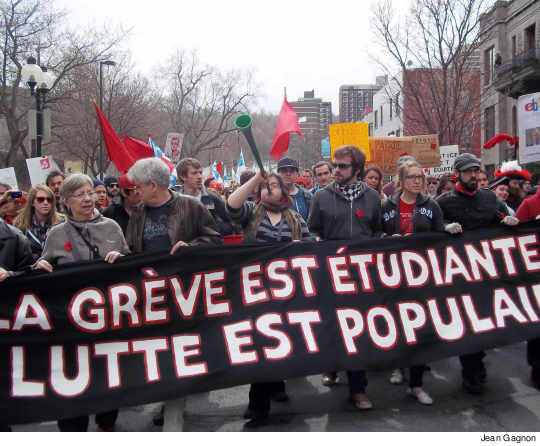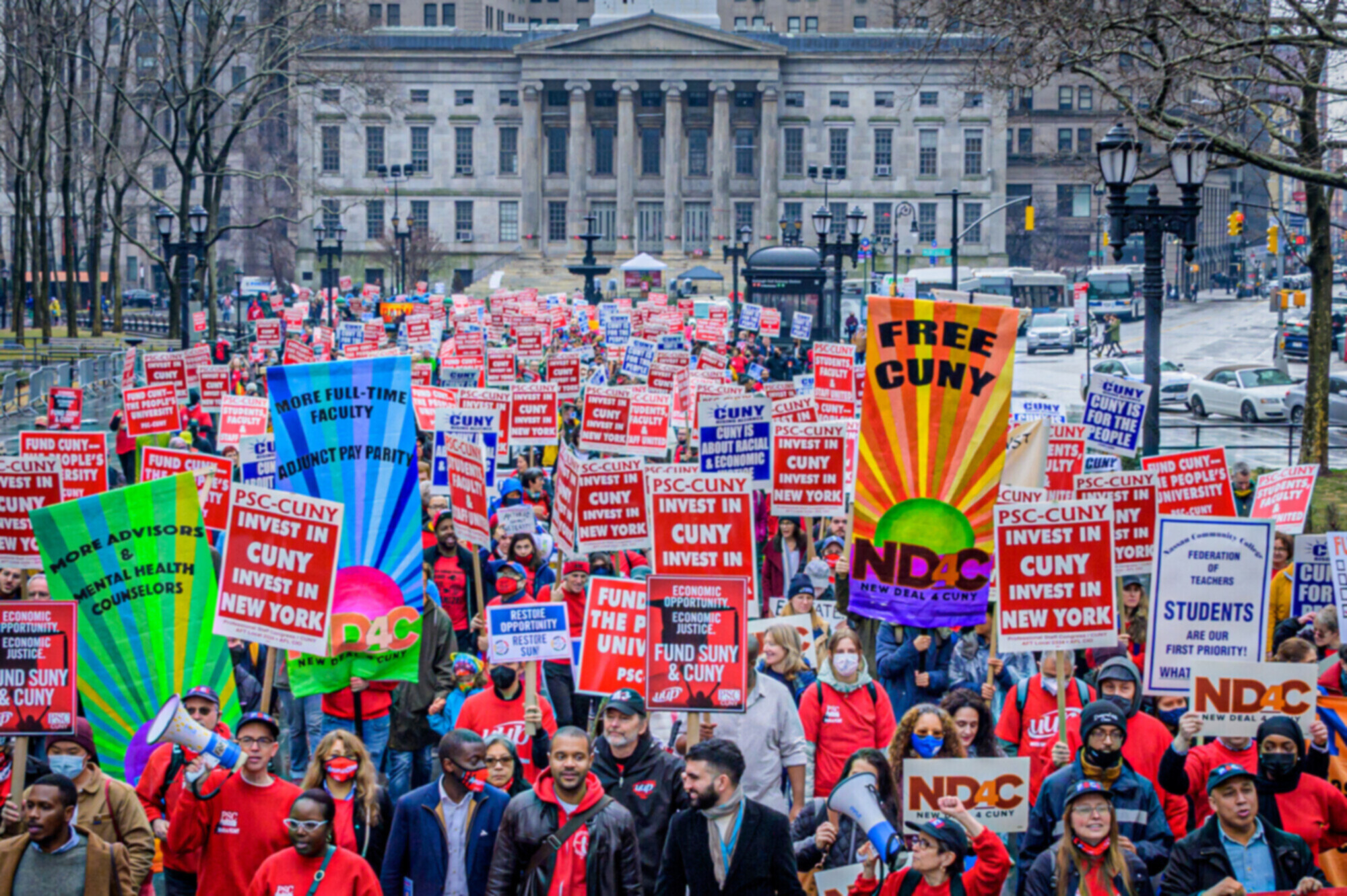 |
MONTRÉAL – Québec students have been on strike now for six months against a planned 75% tuition hike at the public universities over the next five years. It may be the largest student strike in the history of North America – and as the fall semester begins, Québec’s student movement seems ready to keep going.
The major student unions have called for a massive convergence in Montréal in mid-August, during the first week of the academic calendar. A giant march planned for August 22, 2012 could be the largest protest in the history of Québec. These actions will set the tone for the struggle over the coming months, as student unions continue their confrontation with the government of Prime Minister Jean Charest.
Media in the United States have hardly mentioned the Québec student strike, but those of us who have been following the movement have been amazed by the sheer numbers that it has mobilized. Hundreds of thousands have taken to the streets on major days of action: the protest on May 22, 2012 drew an estimated 300,000 to 400,000 people.
This turnout is all the more impressive considering that the march was held in direct defiance of Law 78, the Charest government’s draconian anti-protest law that bans any unpermitted gathering of more than 50 people. The vaguely worded measure threatens enormous fines against organizers, unions and potentially anyone who participates in an unpermitted assembly. But the mass defiance of the law has made its enforcement more or less impossible. On the website “Arrêtez-moi quelqu’un!” (or “Arrest me, someone!”), people post photos of themselves holding signs that declare “I am disobeying Law 78.” Other more everyday forms of resistance are also prevalent.
The red squares that symbolize the student strike are omnipresent in Montréal: pinned in the hair of a girl on the metro, worn as earrings by another, attached to a baby carriage, or duct-taped on backpacks, shoes, bike helmets and cell phones. Most often, the small, red felt squares are safety-pinned to people’s jackets or shirts. The squares are derived from the expression “carrément dans la rouge,” or “squarely in the red.” Besides identifying those who are on strike, they serve as everyday reminders of the crushing student-loan debt that Canadian students already face – on average $27,000, according to the Canadian Federation of Students.
POTS AND PANS
In late May, 2012 we traveled to Québec to talk to student organizers and marched with them in their nightly demonstrations. High-energy marches snaked their way across Montréal for hours, through residential and commercial neighborhoods. People in bars, restaurants and apartment leaned out their windows, cheering and chanting. Often they banged on pots and pans, inspired by the Latin American tradition of cacerolazo protests: Montréal now has its own tradition of les marches des casseroles.
During conversations with our comrades we often expressed disbelief at the size and success of the strike and at the prevalence of red squares. In response people simply said: “Yes, but we have been working for two years to get here.” And it is true. The tuition hikes have been on the table since 2010, when Québec’s tuition freeze ended. In March 2011, Québec announced its plan to raise tuition by $325 a year over five years. In response, protesters occupied the finance minister’s office.
HOW THEY DO IT
When asking how, over that time, so many students have been mobilized and politicized, the answer is both simple and complex. As student organizer Myriam Zaidi said, “We’ve been standing on corners handing out leaflets and having conversations with people about this for years. Just opening up that space of conversation has been hugely important. This didn’t happen overnight.” These basic forms of disseminating information about the tuition hikes and fostering debate about these issues have been pivotal in mobilizing massive on-the-ground support behind the call for a strike.
The movement’s dynamism also stems from the organizing structure and history of student unions at universities in Québec. Organized at many levels – from the whole Québec province down to individual academic departments – these unions provide a way for students to organize politically, granting them both legitimacy and power. Longer-term mobilizing strategies include campaigns to build strike votes at general membership meetings, carefully navigated negotiations with governments and university administrations, and coalition-building between the various unions. These have been pivotal in securing a unified front during the current strike. This round of protests are also only the most recent expressions of a much longer history of radical student unionism: Québec has seen nine student strikes since 1968.
Thanks to this deep organizing, student unions at the Université du Québec à Montréal began with a very strong base of support when they called for a strike on February 14, 2012. Picket lines were organized in front of classrooms, and efforts to blockade buildings and shut down the university required constant organizing and action. As one student organizer told us, “In those first few weeks, it was very tedious. We knew the class schedule, and we would stand outside the classrooms with signs….Many students would know this was going on and just stay home.” The support of professors was pivotal; many simply canceled classes in solidarity. Others were less supportive: one day a right-wing professor charged the picket line.
The university didn’t take these actions lightly. In March 2012, fed up with the pickets and the strike, the university hired a notorious strike-breaking security firm. Armed guards patrolled its hallways, interrogating people about why they weren’t in class, stopping professors and students alike to bully and harass them. This, however, only lasted a few days until widespread outrage from faculty of all political leanings forced the administration to withdraw the guards. The strike continued and grew throughout the spring, prompting the provincial government to call for an early end to the semester in an unsuccessful attempt to break the strike.
EXPANDING
While students are still at its core, the movement in Québec has now grown much wider. Their struggle has resonated with other parts of Québec society in part because the tuition hike is just the latest of many efforts by the Charest government to restrict availability of social services through imposing hefty “user fees,” while reducing taxes on corporations and the rich. Many non-students thus back the student strike as an effective form of resistance to the government’s overall neoliberal agenda. Widespread outrage provoked by Law 78 has also buoyed the movement, and while the government has so far held off from any real attempt to enforce the new law, incidents of police brutality and arbitrary arrests have also rallied others to the students’ side.
There are varying levels of support for the strike at different universities and in different parts of this province of eight million people. At the English-speaking, elite McGill University, support has been sporadic, and the strike there has not been successful (despite a student occupation of McGill’s administrative offices in the winter). In some ways, this is emblematic of historic divisions between the French-speaking and English-speaking communities in Montréal and Québec, and how these divisions also fray along class lines. Occasionally this has meant that the protests have a nationalistic flavor to them, with people carrying the Québec flag and chanting things like: “A qui le Québec? A nous le Québec!” (Whose Québec? Our Québec!)
STUDENTS OF COLOR
These nationalist undertones have been continuously contested by student organizers of color who have been actively working to articulate an anti-racist and anti-colonial analysis within the movement, while also combating the false view that the movement is dominated by white students. These efforts are increasingly successful, as shown by the creation of the students-of-color and anti-racist coalitions that had a presence at the massive May 22, 2012 march.
In the broader frame of electoral politics the student movement is a wild card, with uncertain implications for the Québec elections set for September 4, 2012. With the corporate media generally hostile to the strike, polls show public sympathy for both the students’ and the government’s positions. But Law 78 is largely unpopular, drawing around 60% opposition in recent surveys. Some student groups will be mobilizing voters against Charest’s Liberal Party, while others are keeping their focus on street mobilization and direct action.
For our part, during marches, or while banging pots on street corners with our Montréal comrades, the question most often on our minds was how we in the CUNY system, as students and workers, can stand in solidarity with this struggle. The first answer, of course, is to build our own movement and to build it in explicit connection with the one happening in Québec. We too are facing tuition hikes at public schools, from New York to California. We too are met with repression and violence when we express dissent. The core issues at stake are fundamentally the same for students and workers around the world: the implementation of austerity measures and the increasing privatization of education. What was once a common good is being purposefully transformed into an elite commodity available to only those who can afford it.
We here at CUNY should keep a close eye on what transpires in Québec in the fall, and what student and labor unions are able to accomplish through working together. Movements like Occupy Wall Street grew out of solidarity with the Tunisian, Egyptian, Spanish, and Greek uprisings, after people began asking themselves, “How do we do that here?” Our generation of students in the United States has yet to mobilize on a mass scale, but after watching what’s happening in Québec, perhaps that will start to change.
______________________________
Adapted from an earlier article published at wagingnonviolence.org. For links to news sources about the movement in Québec, see psc-cuny.org/Quebec-Update.

